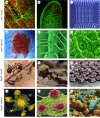Liquid brains, solid brains
- PMID: 31006374
- PMCID: PMC6553592
- DOI: 10.1098/rstb.2019.0040
Liquid brains, solid brains
Abstract
Cognitive networks have evolved a broad range of solutions to the problem of gathering, storing and responding to information. Some of these networks are describable as static sets of neurons linked in an adaptive web of connections. These are 'solid' networks, with a well-defined and physically persistent architecture. Other systems are formed by sets of agents that exchange, store and process information but without persistent connections or move relative to each other in physical space. We refer to these networks that lack stable connections and static elements as 'liquid' brains, a category that includes ant and termite colonies, immune systems and some microbiomes and slime moulds. What are the key differences between solid and liquid brains, particularly in their cognitive potential, ability to solve particular problems and environments, and information-processing strategies? To answer this question requires a new, integrative framework. This article is part of the theme issue 'Liquid brains, solid brains: How distributed cognitive architectures process information'.
Keywords: ants; cognition; evolution; immunology; neurons; swarms.
Conflict of interest statement
We declare we have no competing interests.
Figures


References
-
- Pagán OR. 2014. The first brain. The neuroscience of planarians. Oxford, UK: Oxford University Press.
-
- Llinas RR. 2001. I of the vortex: from neurons to self. Cambridge, MA: MIT Press.
-
- Llinás R. 1987. ‘Mindedness’ as a functional state of the brain. In Mindwaves (eds C Blakemore, SA Greenfield), pp. 339–358. Oxford, UK: Basil Blackwell.
-
- Miguel-Tomé S. 2018. The influence of computational traits on the natural selection of the nervous system. Nat. Comput. 17, 403–425. (10.1007/s11047-017-9619-0) - DOI
Publication types
MeSH terms
LinkOut - more resources
Full Text Sources
